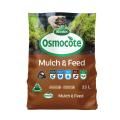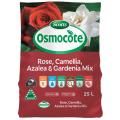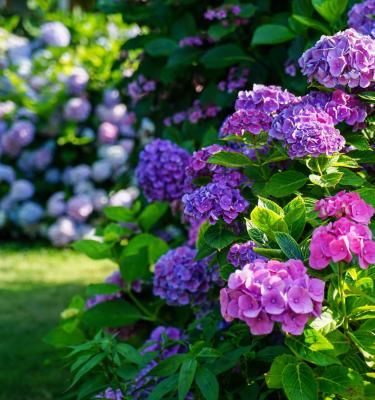

How to grow hydrangea in New Zealand
The hydrangea is one of the most prolific flowering shrubs decorating our gardens, borders and suburban walkways in New Zealand. Its charming clusters of bright, colourful flowers are nostalgic reminders of childhood homes, family Christmas gatherings, and backyard barbeques with friends and neighbours.
A hardy plant, the hydrangea thrives in most climates across the country. Read our guide to growing hydrangeas in New Zealand for tips on planting and caring for this Kiwi garden favourite.
When should you plant hydrangeas?
Hydrangeas can be planted year-round but do best when planted during spring and autumn to avoid extreme temperatures.
When to plant hydrangeas in New Zealand:
- Plant hydrangeas – September to November, March to May
- Pick hydrangeas – December to February
Hydrangea varieties to grow
Kiwi gardeners have access to a diverse range of hydrangeas, and each variety grows well in most soil types.
Popular hydrangea varieties in New Zealand are:
- Bigleaf hydrangea (hydrangea macrophylla): bigleaf hydrangeas produce ‘mophead’ or ‘lacecap’ flowers. Popular bigleaf varieties include Ayesha, Blaumeise, Bloody Marvellous, Bridal Bouquet, Julianna, Machiko, Masja, Trophy
- Panicle hydrangea, also called paniculata hydrangea or Limelight hydrangea
- Oakleaf hydrangea (hydrangea quercifolia), also called Snowflake hydrangea
- Smooth hydrangea (hydrangea arborescens), also called Annabelle hydrangea
- Climbing hydrangea (hydrangea petiolaris)
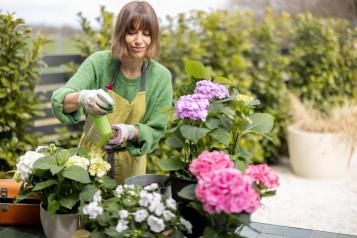
Planting your hydrangea
While hydrangeas are a durable plant, too much sun or heat can shorten the life of the flowers and cause the leaves to brown. Try to find a shady or partially sunny spot to plant your hydrangea.
Note: Avoid planting hydrangeas in the middle of the day as they can be vulnerable in hot sun. Early morning or evening planting times are best.
To plant your hydrangea in the garden:
- Choose a spot that offers shade or partial sun, has plenty of space for larger varieties to grow into, and ideally drains well.
- Apply Scotts Sheep Pellets to the area to improve the quality of your soil and get the best results.
- Dig a hole around twice the width and depth of the pot your hydrangea is currently in and
- Place the hydrangea in the centre and fill the space around it with soil.
- Depending on the season, you might want to add a layer of mulch around the base of the plant.
- Water your freshly transplanted hydrangea.
If you’re transplanting your hydrangea from a pot to the garden, be careful to reduce transplant shock for the plant where possible.
Planting hydrangeas as a hedge
Hydrangeas are versatile and make a great border or flowering hedge. This has the extra added effect of bringing more colour to your garden come summertime.
When planting hydrangeas as hedges, a general spacing rule is to plant them at least one metre apart – but it’s a good idea to research the size of your chosen variety once it matures.
Growing hydrangea in a pot
Hydrangeas perform well in pots – and they’re easier to move around your deck or patio.
To grow your hydrangea in a pot:
- Choose a medium-large nursery pot with drainage holes that can expel excess water.
- Fill the pot halfway with Scotts Osmocote® Rose, Gardenia, Azalea & Camellia Mix.
- Place your hydrangea plant in the centre of the pot and fill the rest of the space around it with soil, making sure the roots are covered.
- Water your cutting, making sure the soil is damp but not drenched.
Growing hydrangea from cuttings
Growing hydrangea plants from cuttings is a fairly simple process. You can trim a small branch from an established hydrangea plant with at least four leaves on it and plant the cutting directly in a pot of soil.
While some might be able to plant cuttings directly into their garden, it’s a good idea to keep them indoors while they establish. This helps them avoid variable conditions like harsh weather or garden pests while they’re young.
Growing climbing hydrangea
Unlike the other types, the hydrangea petiolaris has aerial roots that will latch onto fences, walls, and trees. The climbing hydrangea grows slowly and produces white lacecap flowers. They can even climb the sides of water tanks, brick structures and houses.
Planting and caring methods for climbing hydrangeas are mostly the same. However, make sure to train your climbing hydrangea in your preferred direction. You may also need to prune more vigorously or regularly to keep them away from windows, other plants, or off the ground.
What should you feed hydrangeas?
Hydrangea flowers can change colour depending on the fertility and nutrients of the soil. Here are a few things to keep in mind when deciding what to feed hydrangeas in New Zealand:
- For general care and a healthy shrub, apply Scotts Osmocote controlled release fertiliser for flowers
- To get the most out of your red and pink flowers, you can add lime to your soil
- For deeper blue hydrangea flowers, add aluminium sulphate
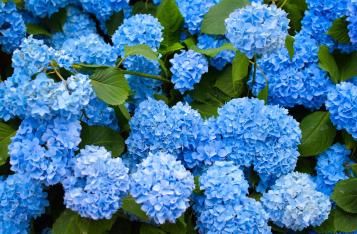
Commons pests and diseases for hydrangea
Keep your hydrangeas healthy by looking out for:
- Powdery mildew: a fungal disease that appears as a light-coloured mould on leaves
- Aphids: small sap-sucking insects found on the stems, or on and under leaves
- Spider mites: tiny insects that spin silk webbing on leaves and stems, feeding on plant cells
Additionally, your hydrangeas may display yellow leaves or leaf spots from time to time. The causes for these conditions can vary, so make sure to inspect your plant carefully before deciding on treatment.
How to prune hydrangeas in New Zealand
Flower buds will start growing on your hydrangea around August to September, giving you a good idea of where the flowers will bloom. Trim around the buds in early spring to get optimal flowering, and prune and remove dead flowers in autumn. You can prune down to about half the plant’s size in autumn.
Make sure to trim after frosts have passed for the winter, so the hydrangea isn’t as vulnerable to extreme temperatures. In frost prone regions and cooler climates leave the spent flowers on the plant until spring to protect the new buds. Prune in early spring - plump buds are flower buds, elongated buds are foliage buds.
Picking hydrangea flowers
Get the best out of your flowers by:
- Choosing mature blooms (and giving younger blooms more time on the plant)
- Picking them when they’re dry
- Cutting the stem on a diagonal slant using sharp, clean tools
- Putting the flowers in water immediately
You can also trim lower leaves and replace the water every few days to preserve your flowers for longer.
Hydrangea growing tips
- Hydrangeas are a low maintenance addition to the garden that look great as a shrub, hedge, or planted po
- You can make your hydrangea flowers more pink or red by adding lime to your soil, or get a deeper blue by adding aluminium sulphate
- Looking for variety? Add a climbing hydrangea to your garden to get more green cover on fences, tanks or structures – and enjoy its large white blooms in summer.
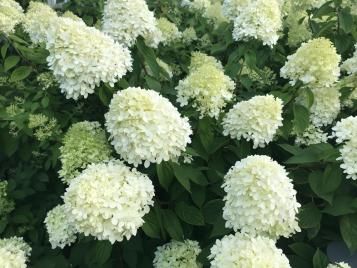
Frequently asked questions
Do hydrangeas like sun or shade?
Hydrangeas don’t like too much harsh sun – it can burn flower petals and wilt leaves. If you can, plant your hydrangea in a partially shady area.
How do I grow white hydrangea in New Zealand?
There are many popular white hydrangea varieties in New Zealand, including: Limelight, Snowball, Bridal Bouquet, and Annabelle.
Unlike other types, white hydrangea flowers will stay white regardless of the soil’s nutrients.
How do I grow blue hydrangea?
Hydrangeas will produce blue flowers in acidic soil. To make your soil more acidic, add aluminium sulphate to the area around the plant. This comes in a salt form, is non-toxic and soluble in water.
Where do hydrangeas grow best?
Hydrangeas grow best in semi-shaded areas with morning sun and afternoon shade. In New Zealand, plant them in well-drained soil enriched with organic matter and ensure regular watering during dry periods.
Can you move hydrangeas in NZ?
Yes, hydrangeas can be moved in New Zealand during late autumn or winter when the plant is dormant. Dig a wide root ball and replant it in a well-prepared, semi-shaded spot. Water thoroughly after replanting.
Can hydrangeas grow in pots?
Yes, hydrangeas grow well in pots in New Zealand. Use a large pot with good drainage and fill it with quality potting mix. Place the pot in a semi-shaded area and water regularly to keep the soil moist.
